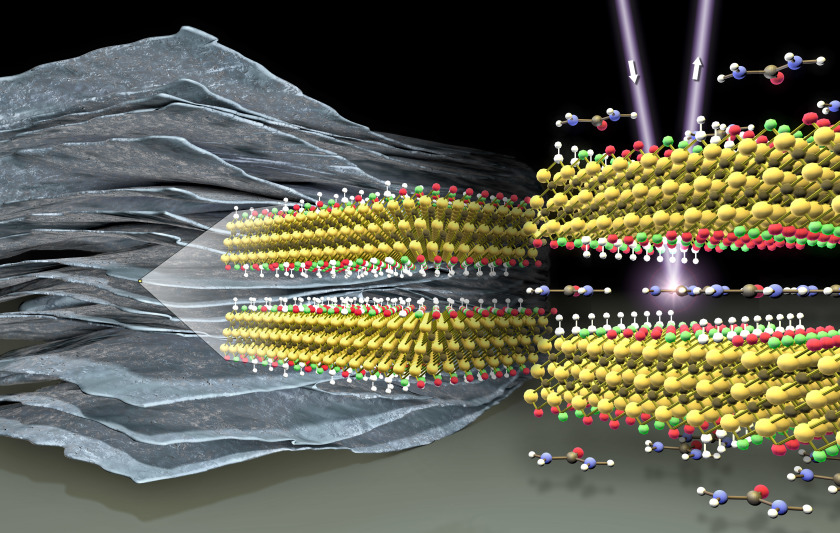Young Investigator Group Nanoscale Solid-Liquid Interfaces
Research Topics
We are interested in fundamental physicochemical processes at solid-liquid interfaces related to energy storage and conversion applications. This involves understanding the interplay between the surface chemistry of nanomaterials and interfacial (or confined) electrolyte, and their respective role on charge transfer processes at the interface. The originality of our group is based on the use of:
-
in situ/operando spectroscopy: benefiting from state-of-the-art infrastructures, we apply a wide range of optical and soft X-ray spectroscopy techniques to monitor nanomaterials, intercalated species or product formation during photo/electrochemical reactions,
-
hyperspectral imaging: Combining spectroscopy with high spatial resolution, hyperspectral imaging allows the characterization of intrinsic materials properties of single entities, such as MXene flakes, and the monitoring of local phenomena that may be screened by averaging over a large area.

Electrochemical energy storage
Electrochemical energy storage relies on the intercalation of charge carriers in a host material, leading to charge transfer upon their (partial) desolvation. We are most particularly investigating pseudocapacitive materials that store energy using reversible surface electrochemical reactions. They may provide solutions to achieve simultaneously high power and energy densities, as they combine some benefits from capacitors (e.g. fast ion diffusion) and batteries (e.g. faradaic charge transfer). Nevertheless, pseudocapacitive energy storage mechanism generally remains poorly understood. We aim at resolving the role of ion (partial) desolvation and redox/faradaic charge transfer in pseudocapacitive charging mechanism using multimodal in situ/operando spectroscopy and microscopy during electrochemical cycling. Using MXenes as a model system of pseudocapacitive materials, we investigate:
-
Redox and faradaic reactions at the interface with the electrolyte,
-
Proton and ion solvation and dynamics in confined interlayer space,
-
Local electrochemical processes over single MXene flakes.
To this aim, we use the high chemical sensitivity of soft X-ray absorption spectroscopy (XAS) to the chemical bonding of transition metal and of surface functional groups. Local spectroscopy at the nanoscale is possible using Scanning Transmission X-ray microscopy (STXM). Raman spectroscopy brings further information on the carbide core and surface groups, while FTIR spectroscopy is particularly sensitive to the solvation state of intercalated species within MXene films. Broadband IR-to-UV ellipsometry further allows quantitative analysis of structural, optical and transport properties in MXene films.

Photo/electrochemical energy conversion
Solid-liquid interface has a predominant role in chemical reactions relevant for photo/electrochemical energy conversion (PEC), such as hydrogen evolution reaction (HER), oxygen evolution/reduction reaction (OER/ORR) and carbon dioxide/nitrogen reduction reactions (CO2RR/NRR). We concentrate our research on sustainable metal-free catalysts, such as carbon nitride (C3N4) and carbon dots or diamond-based materials. Diamond is a wide bandgap semiconductor (5.5 eV), which has the exceptional ability to emit highly reactive solvated electrons in liquid environment under illumination, which can reduce CO2 and N2 molecules directly in their solvated phase. The large bandgap of diamond remains however a drawback for solar-driven applications. One major challenge is therefore to enable the absorption of visible light by diamond and several approaches based on doping, surface functionalization and nanostructuration are currently under investigation. Finally, composite materials with MXene as support catalyst for metal oxide catalysts are also investigated in collaboration with the CE-NESD group.
We apply in situ/operando X-ray and vibrational spectroscopies to:
-
identify possible active sites and reaction intermediates,
-
probe the role of aqueous microenvironment on the reaction path,
-
unravel charge separation and charge transfer processes induced by light illumination.
In addition, SPV spectroscopy is particularly well adapted to the characterization of photoactive materials as SPV signals depend on light absorption, separation of photogenerated charge carriers, charge transport and recombination. Charge separation can be caused not only by drift in a space charge region but also by preferential diffusion, selective charge transfer at interfaces, intra-molecular polarization, dissociation of excitons at interfaces, carrier injection, photo-induced adsorption and desorption of molecules. Therefore, related phenomena can be studied by SPV techniques. However, the complexity of involved phenomena can make interpretation of SPV signals often challenging. We therefore perform correlative study with the other spectroscopy techniques.
